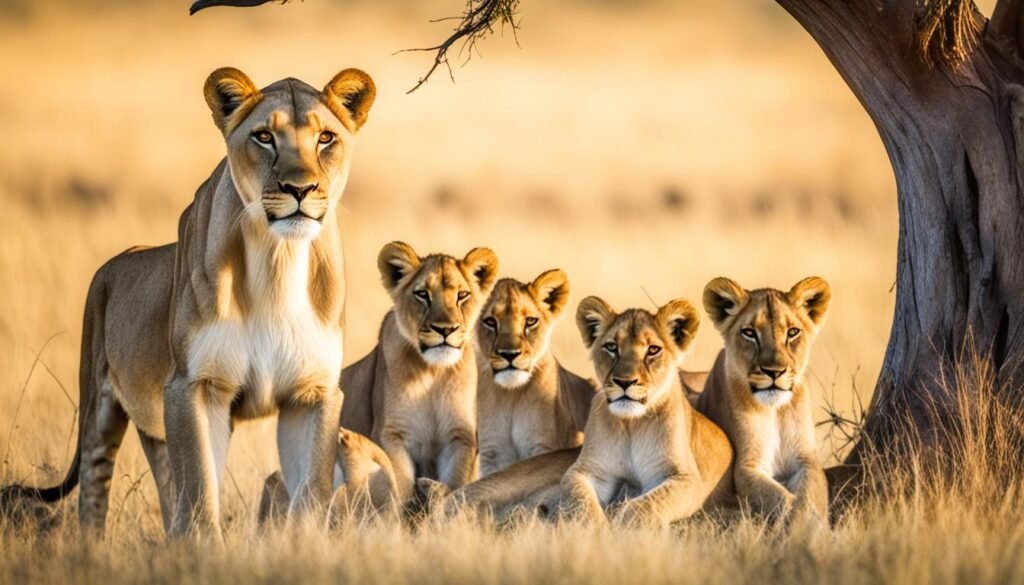The lion is not the ‘king of the jungle’ as often said. Instead, it rules the vast landscapes of Sub-Saharan Africa. There’s also a small group in India’s Gir Forest National Park. In the savannas and grasslands, the African lion has found its domain. This contrasts with the Asiatic lion, which is nearly extinct. With just over 400 left, they live in the dry forests and scrublands of Gir.
Recent stats show a steep decline in African lions, dropping by over 90% in the last 50 years. This is a critical signal for protecting them. On the other hand, Asiatic lions have slightly increased their numbers, thanks to conservation work. Yet, the challenge is huge. Lions are struggling to survive because of humans and environmental changes. We must act to keep their roars echoing in their natural homes.
Introduction to the Mighty Lion
The mighty lion, king of beasts, reflects a deep lion significance stretching back to ancient times. It has journeyed through history to our modern era, where it still stands as a symbol of power and togetherness. These creatures inspire awe and respect, playing a special role in both the wild and our imaginations. This leads to the unique lion symbolism we recognize today.
The Significance of the Lion in the Animal Kingdom
Lions are top predators and greatly impact their surroundings. They are mostly found in sub-Saharan Africa, except for a group of Asiatic lions in India’s Gir Forest. Once widespread, their current numbers show the condition of their habitats. These majestic beings not only symbolize nature’s raw power but also signal its health.
Lions as Symbols of Strength and Community
Lions stand out for their social nature among big cats. Their prides show the perfect mix of individual power and group strength. This structure mainly includes related females and a few males. It highlights teamwork and joint duties. In many cultures, lions represent leadership, bravery, and safeguarding.
| Lion Species | Historic Range | Current Range | Population Trend | Conservation Status |
|---|---|---|---|---|
| Asiatic Lion | Europe, Asia, Middle East | India’s Gir Forest | Stable (Endangered) | IUCN Red List: Endangered |
| African Lion | Europe, Africa, North America | Sub-Saharan Africa | Declining (Vulnerable) | IUCN Red List: Vulnerable |
Despite facing habitat loss, conflict with humans, and less prey, there are success stories in conservation. For example, a lioness in Botswana’s Selinda region helped increase their numbers to around a hundred. This highlights the mighty lion‘s resilience. Similarly, in Kenya’s Masai Mara, local conservancy efforts have made tourism a key support, raising lion populations. These efforts keep the important lion significance alive in these areas.
The Two Subspecies of Lions: African and Asiatic
Lions come in two types: the African and the Asiatic. The African lion is known for its majesty on the savannahs. The Asiatic lion stands out in India’s Gir Forest. They show the different challenges and wins in saving lions around the world.
African Lion: The King of the Savannah
The African lion is crucial in its home. It helps control the number of herbivores and changes the landscape. But, their numbers have dropped vastly. From their original home, they now occupy just 6 percent. Less than 25,000 of them are left in the wild.
They are now in danger due to losing homes, poaching, and fights with humans. Yet, there is hope. Projects in Mozambique and Kenya’s Masai Mara have increased their numbers.
Asiatic Lion: The Rare Gem of Gir Forest
The Asiatic lion lives only in India’s Gir Forest. This single, growing group is a sign of hope. They show how conservation can save a species. Right now, they’re considered Endangered.
India works hard to help lions live with people and other animals. This includes tigers, in carefully managed areas. Still, challenges like less prey due to hunting hurt their recovery.
Efforts to save both lion types show the tight spot they’re in. Their future depends on protecting their homes, stopping poaching, and living peaceably with them.
Unveiling the African Lion’s Domain: Sub-Saharan Africa and Beyond

The African lion, known as Panthera leo, rules over Sub-Saharan Africa. This area is huge and full of different plants and animals. Male lions have big manes and lionesses are strong. They are key parts of this area’s life. The number of lions has gone down by about 43% since the 1990s. This shows why it’s important to protect them.
A big study in 2012 looked into where lions live. It focused on grasslands and woods, where lions make their homes. The work in 2008 also checked how lions are doing and what dangers they face. This information helps people come up with good ways to keep lions safe. Now lions are called Vulnerable, which means they need our help.
Researchers in 2010 studied how trophy hunting affects lions in Tanzania. This hunting changes lion numbers. Knowing this helps us protect them better.
In Kenya, a 2009 survey found new ways to save lions. It looked at how to work with local people. A big count in 2004 checked how many lions are left in Africa. This helps us know where to focus our efforts to save them.
| Year | Findings | Conservation Impact |
|---|---|---|
| 2004 | Inventory of free-ranging lions | Emphasized conservation importance |
| 2006 | Regional strategy formulation | Directed efforts in eastern/southern Africa |
| 2008 | Threat assessment and status | Informed dual conservation strategies |
| 2009 | Social factors and incentive-based management | Explored impact of management in Kenya |
| 2010 | Trophy hunting effects on populations | Provided data for population trend analysis |
| 2012 | Size of savannah Africa | Offered insights into Panthera leo’s habitat |
There are different kinds of African lions because of changes in the land. Around 183,500 to 81,800 years ago, rainforests grew and lions started to change. Then, from 83,100 to 26,600 years ago, the Sahara grew and changed things more.
Today, lions live from South Africa to its northern edges. This shows they have survived many changes. Conservation plans started in 2006 are key. They help protect lions in Sub-Saharan Africa and their entire habitat.
Discovering the Asiatic Lion: A Solemn Resident of India
The focus on saving lions worldwide is crucial. We must highlight the unique group of Asiatic lions in India’s Gir Forest National Park. Unlike African lions, which have lost most of their original habitat, the Asiatic lion lives only in this park. This shows the urgent need to protect them. The Asiatic lion symbolizes India’s incredible wildlife and the need to save such unique species.
India’s Prestigious Gir Forest National Park
The Gir Forest National Park is the last home for the Asiatic lion. This beautiful area requires our full attention to conservation. Here, the presence of the Asiatic lion is both a gift and a duty. It shows India’s commitment to preserving nature. While lions in other places face serious declines, the Gir Forest is a model for living in harmony with nature. This shows that wildlife can flourish if given enough space.
Asiatic Lions: A Struggle Against Endangerment
Asiatic lions are at risk of extinction, which highlights the challenges of saving wildlife. With less than 25,000 lions left in Africa and even fewer in India, their situation is critical. However, conservation efforts in places like Botswana’s Selinda and Mozambique’s Zambezi Delta prove that we can make a difference. The Gir Forest is central to saving the Asiatic lion. It combines science, community work, and policy change to protect this magnificent animal.
- Lion conservations efforts symbolized by the rebirth of populations in Botswana and Mozambique.
- Compensation and incentive programs are reshaping the engagement between local communities and the lion populations they live amongst.
- Continued vigilance and adaptability are required to preserve the delicate balance of the Asiatic lion’s ecosystem.
Understanding the Lion’s Habitat Preferences
The regal lion is a symbol of strength in nature. It prefers certain habitats to live and thrive. These habitats must have enough prey, good hiding spots, and water. Presently, African lions are found in only 6% of their original territory, primarily in sub-Saharan Africa. Sadly, their numbers have fallen to under 25,000. This marks a 43% drop since the 1990s. In contrast, the Asiatic lion exists only in India’s Gir Forest. Here, their numbers show the success of conservation, even though they’re endangered.
Prey Abundance as a Deciding Factor
Lots of prey is crucial for lions. Female lions, the main hunters, need a lot of prey to feed their prides. Conservation efforts focus on making safe areas for lions. These areas help fight issues like poaching and the drop in prey numbers. So, lions can find enough to eat, helping them survive.
The Need for Cover and Water in a Lion’s Habitat
Hiding spots are key for lions to catch prey. The savannahs and thickets of sub-Saharan Africa provide perfect cover. Moreover, despite water being rare, it’s essential. Water areas help lions stay hydrated and also attract prey, affecting where lions live. Knowing this helps conservationists make plans. They aim to protect lions’ future by ensuring they have access to prey, cover, and water.
- African lions have vanished from 94% of their historic range, currently found in parts of sub-Saharan Africa.
- The Asiatic lion’s survival is limited to India’s Gir Forest, highlighting the precarious nature of this subspecies.
- Fewer than 25,000 lions remain in Africa, marking a significant decline over the past quarter-century.
- Efforts to preserve lion populations involve creating protected habitats that cater to their preference for prey abundance, cover, and water.
Exploring the Diverse Ecosystems: Where Do Lions Live in the World?

Lion habitats are in many diverse ecosystems. These ecosystems help lions live in unique ways. Facing shrinking ranges, lions adapt well across different landscapes to meet their needs.
African lions used to roam across most of Africa. Now, they are mainly in sub-Saharan Africa. This shift is due to human activities. Savannas and open woodlands, full of large herbivores, are perfect for them. However, hunting has reduced wild prey, pushing lions to sometimes eat livestock. This causes conflicts with humans.
Asiatic lions live only in India’s Gir Forest. This forest is the last place for the Asiatic lion. Efforts are ongoing to preserve their home. For example, the Selinda Reserve in Botswana and the Zambezi Delta in Mozambique have more lions now. This success is because of hard work in habitat conservation.
- The IUCN says lions are vulnerable, with under 25,000 African lions left. In 25 years, their numbers have halved.
- Hunting and the illegal wildlife trade hurt their numbers. People killing lions in fear adds to this issue.
- To help lions, there are new protected areas and plans to pay locals to live peacefully with lions.
- “Lionscapes” help protect lions and improve the environment. This helps with water, food, and storing carbon, which is good for local communities.
- Lions bring a lot of money through tourism and hunting. This helps African economies every year.
Helping lions means helping people too. It supports jobs, encourages sustainable development, and protects nature. Lions show the health of an ecosystem. Keeping them safe helps us too. This shows how important it is to look after lions and their homes with different conservation methods.
Lion Populations: A Census of the King of the Jungle
Lions have always amazed us with their majesty. Yet, their struggle to survive is deeply troubling. A look at lion populations shows a worrying drop in numbers. This is bad news for ecosystems everywhere. These predators used to roam far and wide. Now, they’re stuck in smaller areas. This makes it urgent to work on lion conservation.
The Diminishing Numbers and Their Causes
In Kenya’s Maasai Mara, lion cubs face tough odds. Half of the male cubs don’t make it to their first birthday. This harsh reality doesn’t end as they grow. Young males lead dangerous lives. Only a few reach ten years of age.
Their life is a tough journey. Many get kicked out of their prides early. They face threats from other lions and the dangers of having no home.
Conservation Efforts to Protect the Roaring Majesty
Despite these challenges, there’s hope. Conservation work has helped. The number of Asiatic lions grew from just ten in the 1800s to over five hundred now. This happened in Gir National Park. Communities there help protect these lions from poachers. This success gives us hope for all lions.
There’s also a project to move some lions to Palpur-Kuno Wildlife Sanctuary. This could help their numbers grow. It makes their future a bit safer.
| Lion Demographic | Statistic | Significance |
|---|---|---|
| Male Lion Cubs in Maasai Mara | 50% mortality in first year | Indicative of the harsh conditions affecting early survival |
| Nomadic Male Lions | Few survive to age 10 | Highlights the dangers faced post-independence |
| Lions’ Reproductive Prime | Ages 5-9 | Crucial period for pride defense and breeding |
| Asiatic Lions in Gir (2015) | Over 500 | Shows population recovery and conservation success |
| African Lions Remaining | About 20,000 | Indicates the disparity and need for increased African lion conservation |
The success with Asiatic lions shows we can save these animals. Yet, African lions still need our help. Their role in the ecosystem and wild symbolizes why we must protect them. The future of lions depends on what we do now.
Threats to Lion Habitats: Conflict and Coexistence
The king of the jungle faces smaller homes and more conflict with humans. Knowing about these fights and protecting homes is key for lions’ survival. This helps ensure lions have a future.
Insights into Human-Wildlife Conflicts
Lions try to avoid places where humans live. But lack of food and broken habitats push them into dangerous areas. Studies show that near humans, like on cattle farms, lions hunt at night. This is their way to deal with human-lion conflicts.
- Lions avoid most human activity, reinforcing the need for reduced human encroachment.
- Nearly 50% of lion habitat lies beyond protected area borders, leading to more frequent human-lion encounters.
- Variable vegetation cover and fluctuating human presence result in lions foraging in riskier areas.
Safeguarding Habitats for Future Generations
Lions face tough challenges like climate change and more humans around. Saving lions means helping local communities live in peace with them. Protecting habitats is key for lions’ freedom and survival. Especially since their numbers dropped from 450,000 to about 20,000.
| Statistic | Impact on Lions |
|---|---|
| Climate change projections in Africa | Increased resource stress, affecting habitats and coexistence strategies. |
| Global lion population decline | Sharp decrease to 20,000 from 450,000 since the late 20th century. |
| Ecotourism industry revenue | Billions potentially funneled into habitat preservation and local economies. |
| Average annual import of lion trophies to the US | 500 trophies highlight the pressure from trophy hunting. |
| Human population growth vs lion population | Lion populations halved with the addition of every billion humans. |
| Toxicity of carbofuran | A quarter teaspoon of this poison can be lethal, demonstrating the risk of human-derived hazards. |
| Goals of the Big Cats Initiative | Aim to double lion populations from their low point by 2015. |
Lions’ Role in the Ecosystem: Who They Share Their World With
Lions go beyond being just apex predators in the ecosystem. African lions balance nature by controlling the numbers of other animals. This shows how important it is to save different kinds of life. In their kingdom, lions live alongside many animals, each important to life’s network.
Co-inhabitants of the Lion’s Realm
In sub-Saharan Africa’s savannas and woodlands, lions live with many species. This includes herbivores and other carnivores. With a decline in large herbivores, vital for lions, the whole ecosystem feels the impact. In places like West Africa, this decline reaches up to 85%.
Impact of Preserving Lion Habitats on Biodiversity
Preserving lion habitats helps the whole biodiversity. It ensures the survival of many species in the same areas. When lions disappear, as seen with a 94% drop in their historical range, the whole ecosystem suffers. But, places like Botswana’s Selinda reserve show that saving lions helps revive the whole biodiversity.
| Conservation Effort | Impact on Lion Population | Wider Ecological Benefit |
|---|---|---|
| Botswana’s Selinda Reserve | Increase from 1 lioness to approx. 100 lions | Improved ecosystem health, increased biodiversity |
| Financial compensation to communities | Encourages locals to coexist with lions | Reduces human-wildlife conflict, fosters habitat protection |
| Mozambique’s Lion Translocation | 24 lions introduced, boosting local populations | Promotes genetic diversity and resilience of lion populations |
Lions are key to sub-Saharan ecosystems as apex predators. Their homes are vital for saving different kinds of life. They live with many species, showing the richness of wildlife. Preserving this biodiversity is crucial for future generations.
Conclusion
In our world, the beauty of lions and their homes shows how rich earth’s life is. We urgently need to save them. Only 11.3% of lion areas have over 1,000 lions. Shockingly, 41.9% have fewer than 50. Places like Maze National Park and Bush-Bush in Somalia are at risk. They need our immediate help.
Only 19.4% of lion areas are under full protection. This leaves too many at risk. The nine populations not in protected areas highlight a big issue in wildlife management. Yet, there’s hope. With better care, lion numbers could grow four times.
The story of lions is one of ups and downs. From Kavango-Zambezi’s conservation wins to the complex issues in South Sudan. This isn’t just about knowing the problem. It’s about taking action. Working together, we can ensure lions thrive on large lands, their roars echoing like in the past.
FAQ
Where do lions live in the world?
Lions live in Sub-Saharan Africa and India’s Gir Forest National Park.
What are the two subspecies of lions?
African lions and Asiatic lions are the two subspecies.
Where can African lions be found?
They mostly live in Sub-Saharan Africa’s grasslands, savannas, and open woodlands.
Where can Asiatic lions be found?
They’re only in India’s Gir Forest National Park.
What are some key features of a lion’s habitat?
Lions need places with lots of prey, good hiding spots for hunting, and water sources.
In what kind of ecosystems do lions thrive?
Lions do well in many places like open plains, dense forests, and grasslands.
Are lion populations declining?
Yes, their numbers have been going down recently.
What are the threats to lion habitats?
Their homes are threatened by human conflicts and growing human areas.
Why are lions important to ecosystems?
As top predators, lions are vital for keeping prey numbers in check and the ecosystem balanced.














